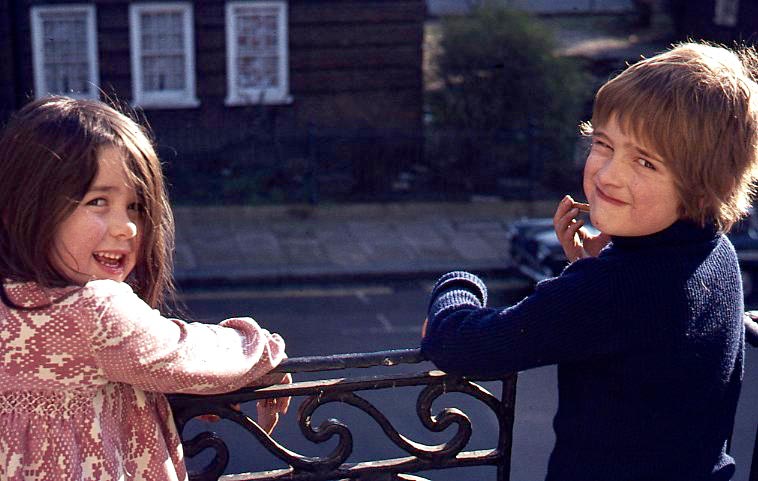
From August 1974, when I produced this photograph of the St Pancras skyline which has now changed considerably, Jessica, Michael, and I lived in a house leased to The Peel Institute, a boys’ club in Lloyd Baker Street in Islington. It was our home on condition that I performed not very onerous caretaking duties in the clubhouse. The Lloyd Baker Estate is a very trendy area in which to live. For us, it was short-term, pending the refurbishment of the very elegant house. We enjoyed a beautiful garden which I was happy to maintain.

Matthew and Becky enjoyed hanging out from the balcony.

Following a very mild summer, on Christmas Day 1974 I picked a bunch of fresh, vibrant roses. I still have the colour slide of Jessica’s photograph to prove it.
Remaining an important community facility, ‘The Peel was founded in 1898 by Sir George Masterman Gillett MP for Finsbury for 14 years. He explained that it was “to supply the young men… with a social centre for recreation, open every evening in the week that the “Peel institute” came into existence”
They met in a Friends’ Meeting house that was previously a woodyard that had manufactured a long wooden instrument called a “Peel” which was used to place bread in huge ovens. The meeting house was commonly known as “The Peel”.
In the first half of the twentieth century The Peel was “a place where the men of the neighbourhood can have a rational evening’s enjoyment without the temptation of the public house” Although influenced by their Quaker faith, there was “an entire absence of thee and thou”.
In the period between the wars the Peel greatly expanded its work, developing a network of illustrious Vice-Presidents and supporters and greatly expanding the number and range of activities.
In 1936 it was said that “in any one week no less than 1,000 families are connected with the Institute, using one or other of its buildings or the Playing Field”
In 1940 the Institute’s headquarters and other buildings around the old courtyard were demolished by enemy action.
The 1952 annual report states that “there is little sign of poverty, young people, both boys and girls, are sturdy in physique well dressed and confident. Most of them read though they seldom write… they earn wages which their fathers, let alone their grandfathers, never dreamed of. The immense housing programme of the local authorities, largely on cleared bomb sites, has totally changed the housing conditions of the people. Nearly every home now has a wireless set, some have television… in spite of the abolition of poverty and the spread of education, men and women of to-day reflect so little on the meaning of life… it is clear that the need for the work and influence of Peel is as great now, for different reasons, as it was half a century ago – or greater, since the new reasons are more vitally important than some of the old ones, as the spirit is more important than the body”
A ‘Peel Old Boys’ club’ was launched which undertook activities such as “gymnastic classes three times per week, 2 football teams, fortnightly whist drives, indoor games, holidays” and in 1958 they established an Old Age Pensioners’ Club
In 1977, the Day centre was opened, running from 10am-4pm Monday to Friday with lunches served and activities e.g. bingo and films, outings. The youth club operated 5 evenings per week. There were 2 clubs; junior and senior. Juniors undertook activities such as “candlemaking badge making, painting and discos” while seniors “more sports orientated” especially football.
The Peel was recognised by a visit from Princess Diana in 1986.
One report states that the neighbourhood has “housing is of a low standard, employment prospects offer few opportunities for personal growth and status. The Kings Cross ‘culture’ presents issues and attractions towards prostitution, drugs, crime and violence”
In 1996 The Peel Centre at Percy Circus opened with areas for day centre and youth club. It was said that “the new centre will provide safe playing space in the Clerkenwell and Kings Cross area for young people of all ages”.
In accordance with the Peel’s plan to “reboot” the charity financially, the Peel Centre was disposed of 2016 in order to release substantial capital funds. The Peel moved its base of operations into the 3 Corners Centre in December 2016 and has adopted a ‘satellite’ model of delivery more appropriate to current and foreseeable needs.’ (https://www.peelinstitute.org.uk/our-history)
We learned later that the second husband of Jessica’s Aunt Elspeth had previously taken parties of boys from the club to climb Snowdon from his cottage in the foothills. My one outing there will follow later.